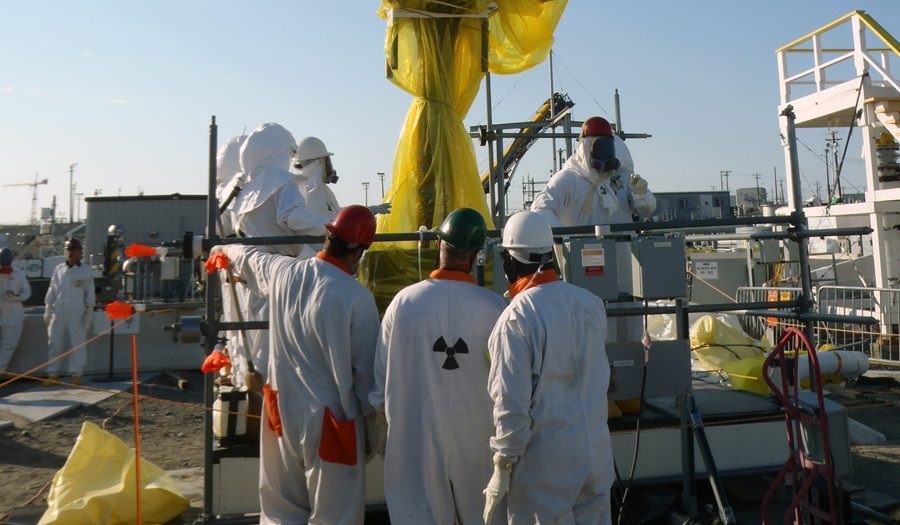
Home » Several major Hanford contracts to be awarded in late summer
Several major Hanford contracts to be awarded in late summer

May 16, 2019
Contracts worth tens of billions of dollars are being
systematically awarded for work to be performed at Hanford, covering prime
responsibilities at the nuclear waste site and operating under new models.
“It’s an important and critical time for collaboration,”
said Mark Heeter, public affairs specialist at the U.S. Department of Energy’s
Richland Operations Office. This includes three major contracts, which are in
the review process with awardees to be announced in late summer.
The largest two contracts will be awarded using the new
“end-state” model and will cover the tank farms and central plateau area of the
site. This model is completed through a two-step process in which the
Department of Energy uses a sample task to find the “best value partner,” and then
“openly negotiates future task orders with the right ‘end-state’ requirements
and regulatory framework that appropriately shares risk.”
Heeter said this risk will now be fairly balanced between
the contractor and the federal government, marking a change to past contract
language.
The upcoming contract with the highest value is for work
currently performed by Washington River Protection Solutions, whose contract is
set to expire at the end of the fiscal year, in September 2019.
Most of the new contracts have new titles, reflecting a
difference in how work is viewed at the site.
Currently known as the Tank Operations
Contract, this contract’s new title is now the Tank Closure Contract, as it
reflects a change in efforts to close the tanks once waste is eventually
processed through the Waste Treatment and Immobilization Plant. Requests for
proposals were due in March and are being evaluated with an awardee likely
announced in late July or August. The contract is valued at up to $13 billion
over a 10-year span and will be awarded under the new end-state model that
includes a goal of reducing risk while accelerating cleanup.
The Department of Energy asked for input from potential
contractors in late 2018 when the bid process began, Heeter said.
“We wanted a spirit of cooperation to make sure we get these
contracts right,” he said. “To look at these contracts and the way we look at
the site, it’s the time to do it differently.”
Heeter said there are opportunities
built into the contract for both the contractor and the federal government to
revisit and potentially renegotiate the terms.
“Everyone is trying to get to the same finish line,” he
said.
A prime contract, the Mission Support Contract, one of the
largest at the site, is now called the Hanford Mission Essential Services
Contract, or HMESC. It’s expected to be awarded by August.
It’s currently held by Mission Support
Alliance and was set to expire in late May, but the company recently received a
six-month extension through November 2019.
MSA, made up of Leidos, Jacobs Engineering and Centerra,
began work on the contract in May 2009.
Heeter said the new contract is likely valued at $4 billion
to $6 billion. This reflects the cost, plus an award fee, cost reimbursement,
and is of indefinite delivery and indefinite quantity, or IDIQ, which includes
a fixed timeline. IDIQ is frequently used for contracts by the federal
government. A four-month transition period is built into the new contract to
allow for the possibility of one contractor departing and a new one entering.
The Department of Energy is reviewing all proposals for the 10-year contract.
The HMESC covers all support services at the site, including
maintaining all infrastructure. This includes security and upkeep of hundreds
of miles of roads, including all utility lines. It also covers firefighting
capabilities, land management, information technology and management of the
HAMMER Federal Training Center. An announcement on the awardee of the HMESC
contract is expected around the same time as the Tank Closure Contract — this
summer.
A third prime contractor is currently completing a
decade-long contract, plus a one-year extension written through the end of the
2019 fiscal year.
Once called the Plateau Remediation Contract and held by
CH2M Hill Plateau Remediation Co., it now is called the Central Plateau Cleanup
Contract and it focuses on the decontamination and demolition of buildings,
excavation of waste sites, groundwater cleanup and management of transuranic
waste.
The CPCC is expected to be awarded at the same time as the
HMSEC and TCC, in July or August. It is valued at up to $10 billion over the
next 10 years. Proposals for this contract also were due in the spring and are
being reviewed. CH2M began the current plateau remediation contract in October
2008, with a focus on cleanup and groundwater.
Bids are expected for a fourth
contract that focuses on samples taken mostly from the tank farms, currently
called the 222-S Analytical Laboratory Services. Its name has been shortened to
222-S Laboratory, and it is expected to be awarded between December 2019 and
February 2020. The contract has been held since fall 2015 by Wastren Advantage
Inc., which was recently acquired by Veolia, based in France. Veolia tests
about 25,000 samples a year in the 200 West Area.
The new 222-S laboratory contract is valued at $600 million
to $1 billion.
“As small-business contracts go, this is a larger one,”
Heeter said.
Heeter said the work has been tied closely to WRPS since the
largest part of the portfolio is analytical work from the tank farms. The new contract
also will cover the cost plus an award fee, as well as cost reimbursement. It
is considered a hybrid fixed price and is also IDIQ.
A contract already is in place with Bechtel National Inc. to
build the massive Hanford Tank Waste Treatment and Immobilization Plant. This
contract is valued at $14.7 billion and Bechtel began work on it in December
2000. The contract is written through 2022 and has no option period. Bechtel is
required to have the plant ready to treat some waste by 2023, but the company
is expected to remain working on the plant through the 2036 deadline when it’s
required to be fully operational.
The contract most recently awarded at the site was for
Occupational Medical Services and given to HPM Corp. As the incumbent provider
of work-related medical services since 2012, this was written using the new
end-state contract model and is being used as a guide for other contracts to be
executed at the site. The new contract with HPMC went into effect April 1,
2019, and is valued at $152 million over seven years.
As new contracts are awarded, Heeter said the Department of
Energy “has a great opportunity to play straight into things and build a
high-performance Hanford team,” allowing the federal government to “be a fair
and demanding customer” to all its contractors.
Local News Hanford
KEYWORDS may 2019





